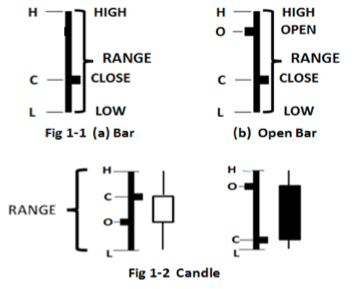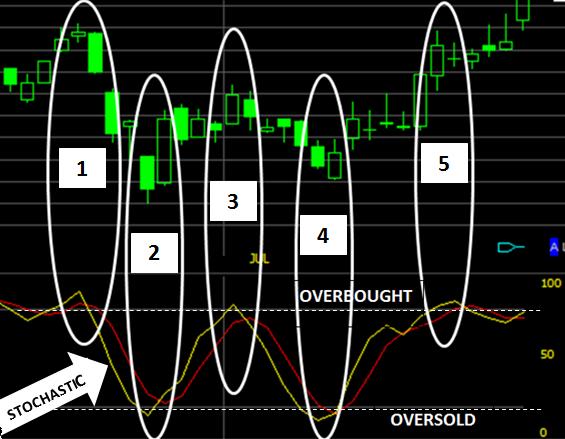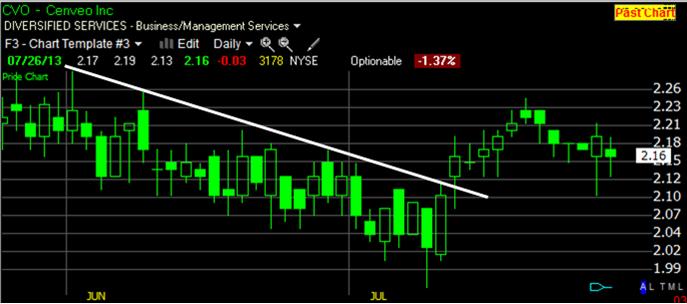We offer a Rolling Stock
Easy Scan® tutorial on our products link. Learn how to set up your own scans. Learn with our products
Technical Analysis Trading is important along with looking at value. But perhaps weighted to a more important level when we understand that when trading, we are considering short term investments.
While fundamental analysis tells us which stocks to buy from the viewpoint of value, the technical trader studies price and volume patterns to know when to buy into a particular stock.
Technical analysts forecast future price movements by reading the supply and demand for a company’s stock and how that affects its price. They use mathematical indicators to forecast the timing of price trends in the market, particularly with charts.
Charts give us insights down the choppy road to trading success. An exciting challenge lies ahead. We want to get from “where we are” to “where we want to be.” Consider being stuck on one side of a river with our objective the palace of prosperity on the other.
Call our challenge a river, one we must cross to reach our objective. The question: What do we need to cross this river?
Rivers have four relevant dimensions;
1. Width; How far are we from where we need to be?
Charts tell us where price must go to meet our objective.
2. Depth; How deep is the river, are there rocks that might damage the hull in crossing?
Volume shown on a chart proves the weight of a price change, or the strength of a trend.
3. Speed; How fast is the water moving?
A moving average on a chart can slow the action, helping us make sense of what its trying to tell us.
4. The nature of flow; are there hidden whirlpools or unexpected white water around the bend to create chaos?
A chart shows us trends (the most widely used charting tool), up, down, or sideways. A trend carries strength within itself, and requires serious market action to reverse.
We must consider all dimensions before choosing a method to cross. Since all rivers have different characteristics, there is no “best-skill” for all problems (or stock selections). We need a set of skills to do our work; rolling analysis, fundamental analysis, technical analysis and news. Charts are used by them all.
Technical Analysis Trading
…uses price and volume data to explain these issues and to perhaps peek behind the curtain to predict an outcome. Predicting future price movement is the goal. Reducing risk along the way while forecasting these movements is what separates winners from losers.
The stock market is manic-depressive which helps explain why the perfect predictive tool does not exist. However, patterns repeat themselves in ways that help predict price movements. Proper use of these patterns and indicators reduces risk, increasing our chance of making money in the market. “Happy-go-lucky” is replaced with tools to recognize opportunity and fend off impending disaster.
Important Technical Tools:
The Price Bar:
A visual look at what price goes through during a market session is shown next. Fig. 1.1(a) shows a Bar with three price points, the High (H), the Low (L), and the Close (C). Fig. 1-1(b) is called the Open Bar, with the added feature of O, or where the price opened during that session.
Figure 1-2 shows the same price information in a Candle format. Here, the candle color depends on whether the price rose or fell during the session. The candle on the left closed higher than it opened, a Gain! So the candle is white. The second candle closed lower, showing black.
Which price bar format to use in your choice with the same information contained in either form. We prefer the candle format for reasons we will cover and will use it predominantly in future posts.
Price:
Prices of most stocks fluctuate within a range forming what are called support and resistance line as shown in Fig. 1. Support is the lower level of a stock’s trading range where there appears to be a limit on further price declines. Resistance is the upper limit of that range where a stock’s price appears to bump against a ceiling.
Fig. 2 Support & Resistance
Technical Analysis Trading
Support and resistance levels have an interesting and important affect on the minds of traders. When the stock price moves up to the ceiling (resistance level), traders see the price less likely to go higher and begin selling the stock. Additionally, a trader who is considering the stock will probably see it as overvalued (over-sold) and delay his investment. Both of these mind games become a self-fulfilling prophecy and indeed, the stock does decline. The same scenario plays out when the stock falls to its support level, with traders willing to buy-in since it looks ready to increase.
This channel created by levels of support and resistance remains in effect until some strong market activity causes a breakout on either the upside or the downside. Rolling stocks demonstrate the action of support and resistance quite dramatically and show how we can take advantage of this market phenomenon.
Fig. 3 Support & Resistance
Technical Analysis Trading
Notice in Fig. 3, the five areas shown with the white ovals. These points show where the price hits support and resistance, but not at the same levels. Points 1, 3, and 5 are resistance, while 2 and 4 show support. How can we use the support/resistance values when they don’t occur at the same place, forming a clear channel, as in Fig. 2?
We’ll learn the technical signals used to cover this short-fall, with an indicator called the Stochastics. Notice the clear channel formed below the price data in Fig. 3, between what is called the Overbought and Oversold areas. The Stochastics is a technical oscillator that senses when buying is slowing down on the top, and when selling is waning on the bottom. The Stochastic is the yellow line with the red a smoothing moving average of the yellow. When yellow crosses up through the red, a buy signal is the call. With the yellow crossing down through the red, selling predominates and its time to sell. Oversold and overbought signals are 20 and 80, as shown. A lot of normal action occurs between these two values, without sending us action signals.
Trend-lines:
Price movements in a single direction, up or down, form important trendlines. The strength of a trend can stampede a bull market to impressive highs and a bear market to worrisome lows. The trend helps us make intelligent buy and sell decisions and it is critical we know where the stock is relative to its trend-line. Figure 4 graphically shows this.
Fig. 4 Trend Line under a rising stock.
Technical Analysis Trading
A trend line is defined as any time three or more price points lie in a straight line. This can be a trend up, down, or flat. In an up-trend, the line is drawn below the price action, serving as an alert if the price falls below the trend as Fig. 4 shows.
Fig. 5 Trend line above a falling stock.
Technical Analysis Trading
This trend line is drawn above a down-trend, serving the same purpose to flag a change in direction, on the upside.
Volume:
The level of trading activity is very important. High volume signals increased investor interest. However, we must know what the price is doing to get any value from volume. For example, a positive trend is in place when price and volume increase together. However, increasing prices on decreasing volume tells us the trend is weakening. Get ready for a price decline.
On the other side, when price and volume decrease together, look for a continuing slide. Decreased selling volume must take place to slow the decline, which will not start back up until buying increases (Fig. 6).
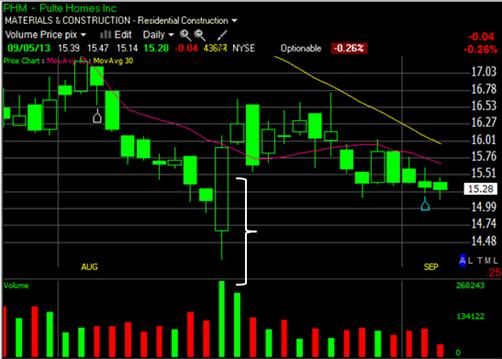
Fig. 6 Volume and price interaction.
Notice in Fig. 6 how increased volume is accompanied by the drop in price. Selling predominated at this time.
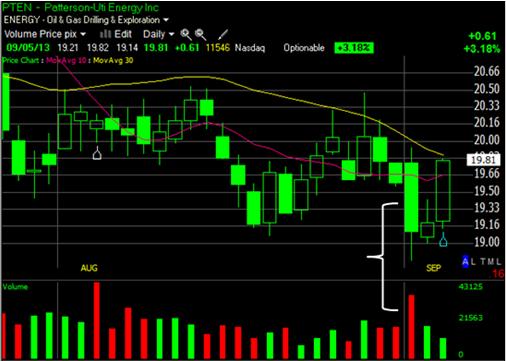
Fig. 7 More Volume/Price interaction.
We’ve suggested several ways to check the signals that tell us whether its time to try to cross the river or not. Is it too wide, or too deep, or too fast moving, or just too many unknowns to take the risk? Technical analysis will help us make these heady decisions, with a level of confidence that will let us sleep when the wind blows.
“Problems are only opportunities in work clothes.”
Henry J. Kaiser
In a word – INSIGHT!

